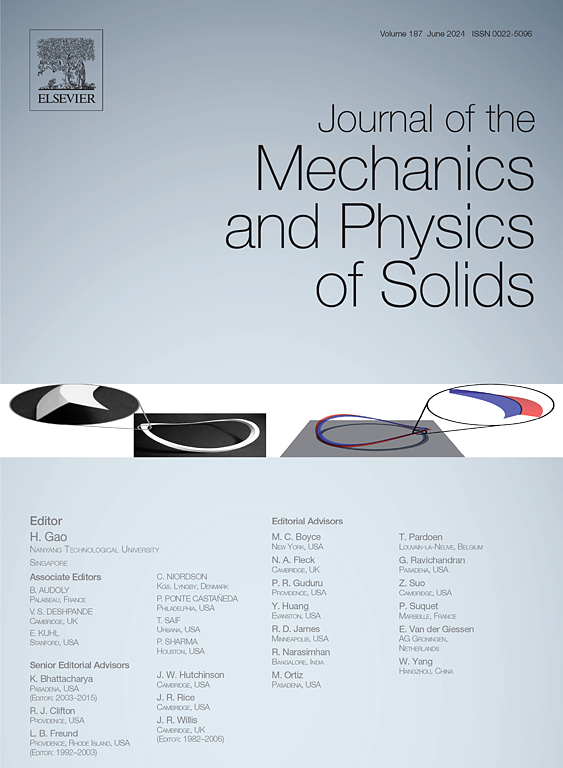弹性介质前传播非保守相场模型的统计力学推导与实现
IF 6
2区 工程技术
Q2 MATERIALS SCIENCE, MULTIDISCIPLINARY
引用次数: 0
摘要
在过去的几十年里,相场建模已经成为介观科学的一种标准模拟技术,它允许运动界面的无缝边界跟踪,并且相对容易与其他物理现象耦合。然而,尽管相场建模取得了广泛的成功,但除了少数情况外,它在很大程度上仍然是由现象学的理由所驱动的。在这项工作中,我们利用最近开发的非平衡现象的统计力学框架,称为带有内变量的随机热力学(STIV),提供了一个非保守相场模型的第一个推导,用于跟踪一维弹性介质中的前沿传播,而不需要诉诸现象学或拟合实验或模拟数据。在所得模型中,变量相对于非平衡自由能服从梯度流动,尽管值得注意的是,应变和相变量的动力学是耦合的,而自由能泛函在相场变量Φ中是非局域的,这种非局域性偏离了传统的|∇Φ|2形式。此外,在这里分析的系统中,该模型准确地捕获了过渡锋的应力诱导成核,而无需纳入额外的物理。我们发现STIV相场模型优于微观系统的朗格万模拟,我们提供了两个数值实现,使一个能够模拟任意原子间电位。本文章由计算机程序翻译,如有差异,请以英文原文为准。
A statistical mechanics derivation and implementation of non-conservative phase field models for front propagation in elastic media
Over the past several decades, phase field modeling has been established as a standard simulation technique for mesoscopic science, allowing for seamless boundary tracking of moving interfaces and relatively easy coupling to other physical phenomena. However, despite its widespread success, phase field modeling remains largely driven by phenomenological justifications except in a handful of instances. In this work, we leverage a recently developed statistical mechanics framework for non-equilibrium phenomena, called Stochastic Thermodynamics with Internal Variables (STIV), to provide the first derivation of a non-conservative phase field model for tracking front propagation in a one dimensional elastic medium without appeal to phenomenology or fitting to experiments or simulation data. In the resulting model, the variables obey a gradient flow with respect to a non-equilibrium free energy, although notably, the dynamics of the strain and phase variables are coupled, and while the free energy functional is non-local in the phase field variable , such non-locality deviates from the traditional form. Moreover, in the systems analyzed here, the model accurately captures stress induced nucleation of transition fronts without the need to incorporate additional physics. We find that the STIV phase field model compares favorably to Langevin simulations of the microscopic system and we provide two numerical implementations enabling one to simulate arbitrary interatomic potentials.
求助全文
通过发布文献求助,成功后即可免费获取论文全文。
去求助
来源期刊
CiteScore
9.80
自引率
9.40%
发文量
276
审稿时长
52 days
期刊介绍:
The aim of Journal of The Mechanics and Physics of Solids is to publish research of the highest quality and of lasting significance on the mechanics of solids. The scope is broad, from fundamental concepts in mechanics to the analysis of novel phenomena and applications. Solids are interpreted broadly to include both hard and soft materials as well as natural and synthetic structures. The approach can be theoretical, experimental or computational.This research activity sits within engineering science and the allied areas of applied mathematics, materials science, bio-mechanics, applied physics, and geophysics.
The Journal was founded in 1952 by Rodney Hill, who was its Editor-in-Chief until 1968. The topics of interest to the Journal evolve with developments in the subject but its basic ethos remains the same: to publish research of the highest quality relating to the mechanics of solids. Thus, emphasis is placed on the development of fundamental concepts of mechanics and novel applications of these concepts based on theoretical, experimental or computational approaches, drawing upon the various branches of engineering science and the allied areas within applied mathematics, materials science, structural engineering, applied physics, and geophysics.
The main purpose of the Journal is to foster scientific understanding of the processes of deformation and mechanical failure of all solid materials, both technological and natural, and the connections between these processes and their underlying physical mechanisms. In this sense, the content of the Journal should reflect the current state of the discipline in analysis, experimental observation, and numerical simulation. In the interest of achieving this goal, authors are encouraged to consider the significance of their contributions for the field of mechanics and the implications of their results, in addition to describing the details of their work.

 求助内容:
求助内容: 应助结果提醒方式:
应助结果提醒方式:


